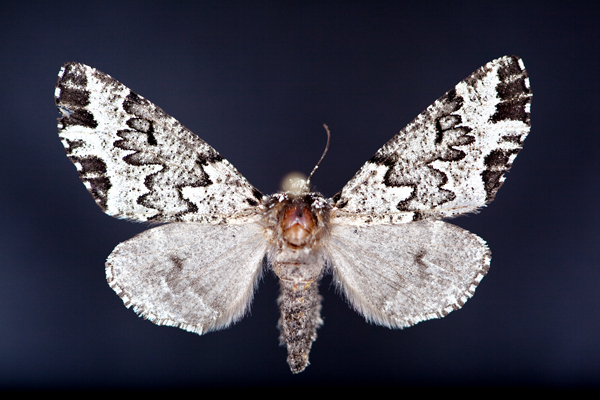This Monday’s moth is a spectacular species from the mountains of Arizona – Chiricahua multidentata, a Geometrid. The only known location for this species is at the very top of the Chiricahua mountains above 9,000 feet (which was just bruned to a crisp). Hopefully the fire was not entirely devastating and the population will rebound in the years to come. Áður 2009 this moth was known from fewer than 10 eintök, all captured at the slightly lower elevation on Onion Saddle in the Chiricahuas. In the spring of 2009 access to a gated road lead to the collection of dozens of specimens in a single night. All of the previous records had been rare strays that had flown down to 8500′ – but the simple act of driving up an extra 1000′ 500’put the collector in the ideal habitat and surprisingly this moth was common! This seems to be par for the course with most insects, very few are actually rare while the rest are just difficult to capture. Either they don’t come to lights, don’t forage within arm’s length, or only live in hard to access habitats. Once you discover their biology (or get lucky) you usually can find the animal in abundance.
You might have also noticed the regular posting of Monday Moth – I’ve been out in the field for the last two weeks and had a stack of scheduled posts. I should start mixing things up more now!


Svo, now you’ve got me wondering what this species depends upon (vegetation: food for self & progeny, shelter) and how that responds to fire…
Já, indeed, re: things that live near roads and trails SEEM v. common vs. things that avoid same. Reminds me of a story of an older gentleman who lived I think in Owens Valley?? My moth friend said this guy had seen a particular moth only when it was below 32 dF (forgive me if I’m repeating myself), Ég held 27 or so, and no body believed him. Then the guys went out to try and find it. 32 F, no moth. 30 F, no moth, 27 F, this moth starts flying around. Do you know this story and/or the moth?
=) Einhvern veginn, thanks for the post of the lofty moth.
I’m not sure I’ve heard the exact story you’re recalling – but I know of lots of examples like this. I just collected a series of Gazoryctra wielgusi in Arizona and they only fly for 15 minutes between 7:45 og 8 (later in August they fly a little earlier, but still for 15 minutes). I actually set my alarm on my phone and the first moth flew in at 7:47 and the last one at 7:58. Amazing!
Raunverulega, even more subtle than this. The elevation difference is closer to 500 feet, and the vegetation looks very much the same at the higher location than down at Rustler Park/Onion Saddle
Thanks for the clarification!
Vá, super interesting (745 – 8).
Do you know the plant species your Monday Moth depends upon?
Officially the host plant is unknown – but one female did lay eggs on a pine stem when offered a large choice of local plants. The egg’s didn’t hatch, but it’s not too unreasonable to guess pine is preferred.